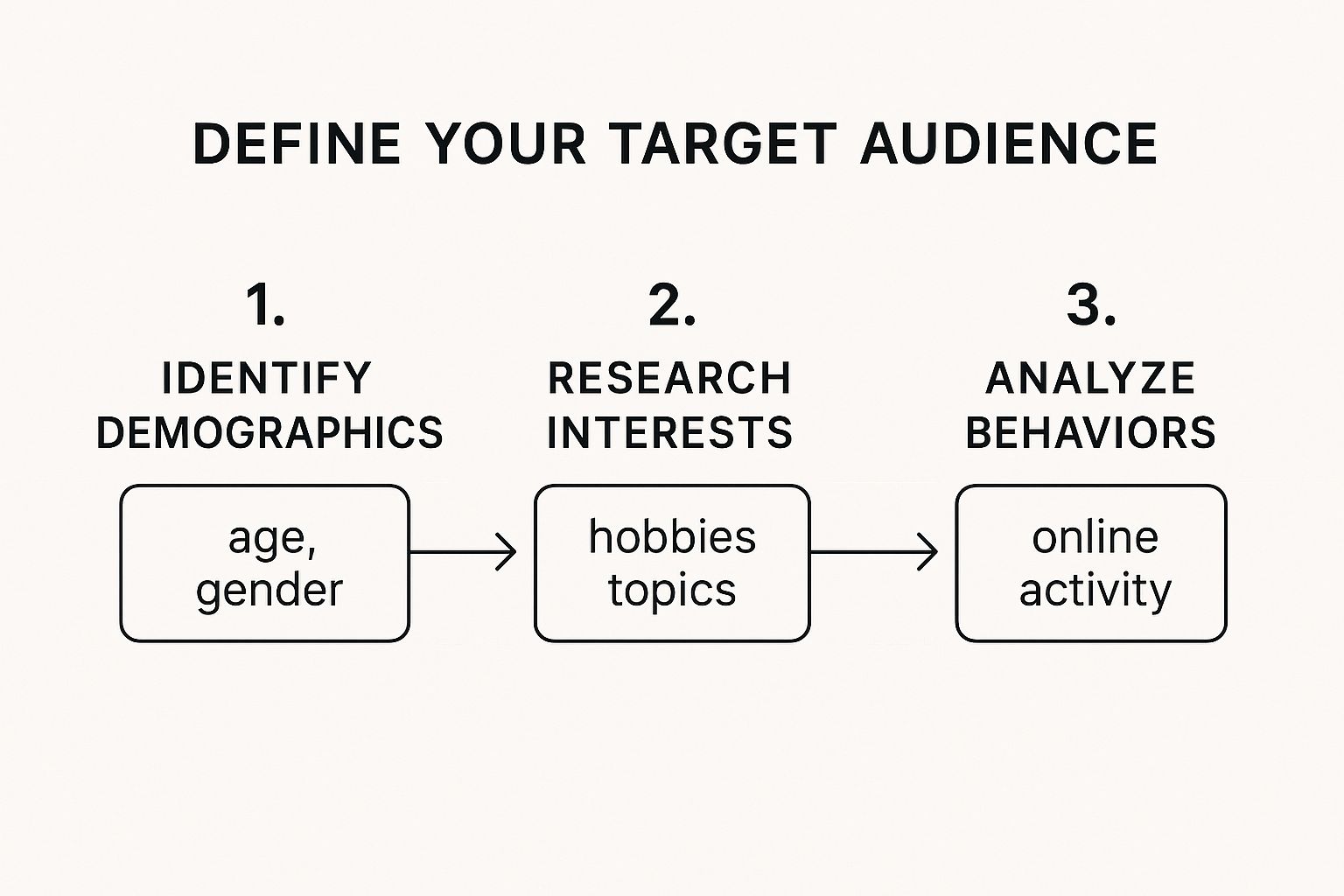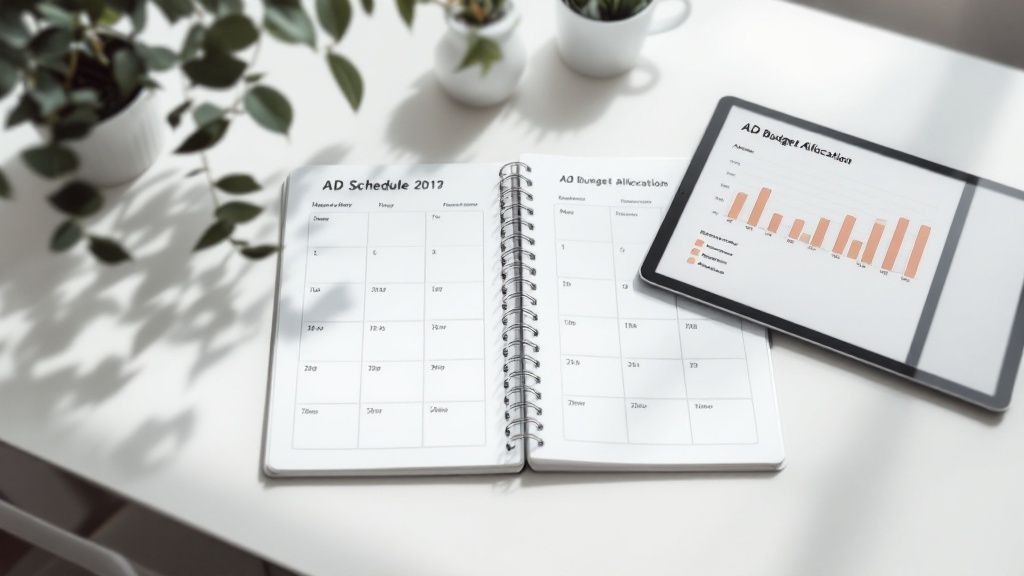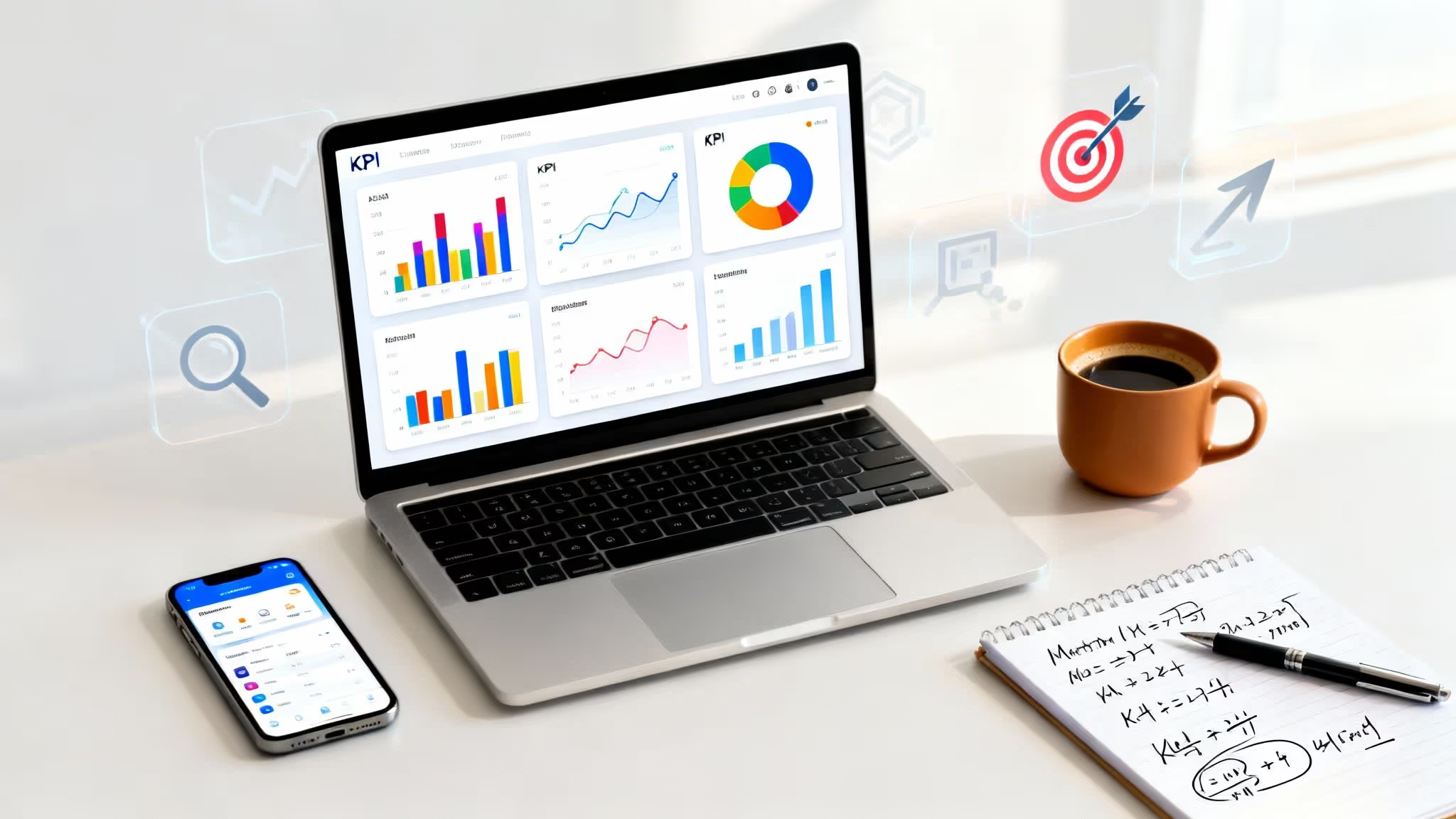To get real results from social media ads, you need a solid game plan. It starts with clear objectives, a deep understanding of your ideal customer, and a smart platform choice. This initial planning is everything—it's what separates profitable campaigns from expensive experiments by making sure every ad dollar has a purpose.
Building Your Foundation for Profitable Ads
Jumping into creating social media ads without a clear plan is like setting sail without a map. You might get lucky, but you'll more likely end up wasting time and money. The key to advertising your business effectively on social media lies in the strategic groundwork laid before you ever spend a dime. This isn't about guesswork; it's about making deliberate, informed decisions that will guide your entire campaign.
A strong foundation begins by defining what success actually looks like for your business. Vague goals like "more brand awareness" are insufficient. You need sharp, measurable objectives.
Define Your Campaign Objectives
First, what do you want your ads to achieve? The answer will shape every other decision you make, from the ad format you choose to the call-to-action you write. Your goal needs to be specific and quantifiable.
- Lead Generation: Are you trying to fill your sales pipeline with qualified leads? Your objective might be to capture a specific number of email sign-ups for a webinar or downloads for a new whitepaper.
- Website Traffic: Is the main goal to drive more visitors to a new product page or a high-value blog post? Here, you’ll focus on metrics like click-through rate (CTR) and cost-per-click (CPC).
- Direct Sales: For an e-commerce brand or a service-based business, the bottom line is often immediate revenue. Success is measured by conversions and, most importantly, your Return On Ad Spend (ROAS).
By setting a clear objective first, you create a benchmark for performance. This turns your advertising from a cost center into a predictable growth engine, where you can directly trace your investment to tangible business outcomes.
Create Detailed Audience Personas
Once you know your goal, you have to get crystal clear on who you're trying to reach. Going beyond basic demographics like age and location is essential for creating ads that truly connect. A detailed audience persona captures the motivations, challenges, and online behaviors of your ideal customer.
Think of it as building a complete profile of a real person. What are their professional challenges? What are their career ambitions? What kind of content makes them stop scrolling?

This deeper insight allows you to craft messages that speak directly to their needs, making your ads feel less like an interruption and more like a solution.
Select the Right Social Media Platforms
With a clear objective and a detailed persona, choosing the right platform becomes a logical next step, not a random guess. The question isn't, "Which platform has the most users?" It's, "Where does my target audience actually spend their time and actively engage?"
The scale of social media presents a massive opportunity. As of early 2024, there are over 5 billion active social media users worldwide, representing more than 62% of the global population. This audience is not only huge but also highly engaged, making it a fertile ground for targeted advertising.
To help narrow it down, here’s a framework for thinking about where your audience lives online.
Platform Selection Framework: Your Audience Snapshot
This table gives you a high-level look at the major platforms so you can match your audience's profile to the right environment.
Your platform choice should always follow your audience. A B2B consulting firm targeting C-suite executives will find far more traction on LinkedIn than on TikTok. Conversely, a direct-to-consumer fashion brand aiming for a younger crowd will almost certainly prioritize Instagram and TikTok. Understanding these nuances is a core reason why social media marketing is important for any modern business looking to grow.
Creating Ads That Actually Stop the Scroll
In the endless feed of social media content, your ad gets less than a second to make an impression. With global social media ad spend projected to exceed $219 billion in 2024, simply having an ad in the feed is not enough to guarantee attention. You need to create something that shatters the mindless scroll. To see just how dominant this space has become, you can discover more insights about social media advertising statistics on Sprout Social.
The secret is realizing your audience isn't hunting for ads. They're looking for value, entertainment, or a solution to a problem. Your creative—that potent mix of visuals and words—is your one shot to prove you're exactly what they need.
Mastering Ad Creative That Connects
The visual element of your ad does the initial heavy lifting. Whether it's a slick image, a carousel, or a video, it has to be visually arresting and evoke an emotional response. A grainy, low-effort photo is a death sentence. Your visuals need to feel native to the platform while reinforcing your brand identity.
Video, in particular, has become a juggernaut for engagement. A majority of consumers report that video helps them make purchasing decisions, making it an indispensable tool in your advertising arsenal.
Your ad creative should solve a problem or tap into an aspiration. Don't just show your product—show the outcome it creates. A B2B software ad shouldn't be a boring screenshot of the interface. It should be an image of a calm, organized professional who just conquered their chaotic workday, thanks to your solution.
Writing Compelling, Benefit-Focused Copy
Once your visual has bought you a few seconds, your copy has to close the deal. The most common mistake businesses make is focusing on features instead of benefits. Your customer doesn't care that your software has "AI-powered integration"; they care that it saves them 10 hours of manual data entry every week.
You have to translate your features into real-world wins:
- Feature: "Our CRM has automated workflows."
- Benefit: "Spend less time on repetitive tasks and more time closing deals."
- Feature: "We use premium, ethically sourced materials."
- Benefit: "Invest in quality that lasts and feel good about your purchase."
This benefit-first mindset speaks directly to your audience's pain points and desires, making your offer infinitely more compelling. The right video can drive this message home with incredible power. For a deeper look, check out our guide on the role of video in social media marketing to see how it can transform your campaigns.
The Anatomy of a High-Converting Call-to-Action
Your Call-to-Action (CTA) is the final, critical piece of the puzzle. It needs to be clear, direct, and simple. Vague CTAs like "Learn More" can work, but specific, action-oriented language almost always performs better. Tell people exactly what to do and what they’ll get.
Effective CTAs create urgency without sounding desperate:
- "Download Your Free Template Now"
- "Claim Your 20% Discount"
- "Start Your 14-Day Free Trial"
Ensure the CTA button and your ad copy are perfectly aligned. If your ad promises a free guide, the button should say "Download the Guide," not "Submit." This consistency builds trust and is a simple way to boost conversion rates.
Finding What Works with A/B Testing
You're not going to nail your ad creative on the first try. The key to long-term success is systematic A/B testing. This involves creating different versions of an ad and running them against each other to see what resonates.
The trick is to test one element at a time for clean, reliable data. You can test:
- Headlines: Pit a question against a bold statement.
- Visuals: Try a clean product photo versus an aspirational lifestyle image.
- Copy: Test short, punchy copy against a longer, story-driven version.
- CTAs: See if "Shop Now" outperforms "Get a Free Quote."
By methodically testing and iterating, you replace guesswork with data. This cycle of continuous improvement turns a good campaign into a great one, ensuring every dollar you spend is working as hard as possible.
Getting Serious with Ad Platforms and Advanced Targeting
Anyone can boost a post. The serious ROI is made when you master the powerful targeting tools within ad platforms. This is where you go from shouting into the void to having a persuasive conversation with the exact person who needs to hear your message.
A well-built campaign isn't just about organization; it's your control center. Think of it as a simple hierarchy:
- The Campaign defines your overarching goal (e.g., generating leads).
- The Ad Set is where you define your audience, budget, and placement.
- The Ad is the creative—the image or video and copy they see.
This structure allows you to test, tweak, and optimize effectively.

Organization is just the start. The real magic happens when you dive into targeting options that go beyond simple demographics.
Moving Beyond Basic Demographics
Knowing your audience's age and location is table stakes. The best campaigns are built on audiences defined by behavior, intent, and existing relationships. This is where things get interesting.
Here are three types of advanced audiences you need to be using:
- Custom Audiences: This is your own data put to work. You can upload a list of customer emails or phone numbers, and the platform finds their profiles. It’s a direct way to re-engage past customers or upsell current ones.
- Lookalike Audiences: This is one of the most powerful tools in digital advertising. You provide a source audience—like your best customers—and the platform's algorithm finds millions of new people who share similar characteristics. It’s prospecting on steroids.
- Pixel-Based Retargeting: The tracking pixel on your website is a goldmine. It tracks who visits and what they do, letting you create hyper-specific audiences, such as people who added a product to their cart but didn’t buy.
These aren't just fancy features; they're about being smarter with your budget. You focus your ad spend on people who have already shown interest, which dramatically cuts down on waste and makes your ads feel far more relevant.
How This Looks in the Real World
Let's make this practical.
A B2B software company could upload a Custom Audience of leads who downloaded a whitepaper but never booked a demo. The ad they see could be a targeted case study and a direct invitation to schedule a call, moving a warm lead down the funnel.
An e-commerce brand can take its list of high-value, repeat buyers and create a 1% Lookalike Audience. This tells the platform, "Find me the top 1% of users in this country who look just like my best customers." It’s an efficient way to find new buyers with a high potential lifetime value.
The core idea is to stop broadcasting to everyone and start having conversations with the right people. Advanced targeting makes your ads feel less like an interruption and more like a helpful solution, which is how you maximize your return.
Layering Your Targeting for Maximum Impact
The real power move is combining these audiences. For example, you can use your pixel data to retarget website visitors who spent the most time on your pricing page—a huge signal of purchase intent.
At the same time, you can exclude your existing customers (using a Custom Audience) from your prospecting campaigns that target a Lookalike Audience. Why spend money trying to acquire customers you already have?
Different platforms also have unique strengths. LinkedIn is unbeatable for B2B, letting you target by specific job titles, company sizes, or industries. On the other hand, a platform like TikTok is all about fast-moving trends and user behavior. To get a feel for that dynamic environment, it's worth learning how to utilize TikTok to market your services or products as a complement to your other ad efforts.
By structuring your campaigns thoughtfully and layering these advanced targeting tools, you graduate from "running ads" to building a sophisticated, scalable system for acquiring new customers. It requires more strategic thinking upfront, but the payoff in performance is massive.
Smart Budgeting and Bidding Strategies
"How much should we spend on this?" It's a critical question for social media ads. Many businesses get tripped up here. They either budget too little to make an impact or overspend without a clear plan and wonder where the money went.
Smart budgeting isn't about pulling a number out of thin air. It’s about making a calculated investment designed to bring back measurable results.

First, get comfortable with your two main options. Most platforms offer a daily budget or a lifetime budget. A daily budget tells the platform to spend a specific amount each day, perfect for "always-on" campaigns needing consistent ad delivery.
A lifetime budget sets a total spend for the entire campaign. This gives the ad algorithm more freedom to spend more on days with better opportunities. For instance, a B2B firm promoting a month-long webinar series might use a lifetime budget, allowing the platform to automatically increase spending as the event nears. An e-commerce brand with an evergreen sales campaign, however, would likely stick with a steady daily budget.
Aligning Your Bidding Strategy with Campaign Goals
Your budget is the ceiling, but your bidding strategy is the instruction manual. It tells the platform how to spend that money. This choice must match your objective. Trying to get sales while your bid strategy is optimized for clicks is like using the wrong tool for the job.
Here’s a rundown of common bid strategies:
- Cost-Per-Click (CPC): You pay when someone clicks your ad. This is your go-to when the goal is driving traffic to a landing page or blog post.
- Cost-Per-Mille (CPM): You pay for every 1,000 impressions (views). It's all about reach. Use this when your primary goal is getting your brand in front of as many people as possible.
- Conversion-Focused Bidding: This is where the magic happens for lead generation and sales. You're telling the platform, "Find me people most likely to take the action I want," whether that's filling out a form or making a purchase.
A common mistake is obsessing over a low CPC. A higher CPC that brings in a high-value customer is infinitely more profitable than a dozen cheap clicks that just bounce. Always focus on the cost per outcome.
To do this right, you must know your numbers. Metrics like customer lifetime value (CLV) are your north star—they tell you how much you can afford to spend to acquire a new customer. If you need a refresher, our guide on how to calculate return on ad spend breaks it down perfectly.
The Art of the Test Budget and Scaling Intelligently
Before committing a large budget, you must test. Start with a modest test budget, enough for the ad platform's algorithm to exit its "learning phase," but not so much that a flop will sink your week. This phase is when the algorithm gathers data to learn who responds to your ads. A common rookie error is interrupting this process by making too many changes or setting a budget that's too small for the system to learn.
So, what’s a good starting point? A budget that allows for at least 50 conversions per ad set per week is a solid benchmark for platforms like Meta to exit the learning phase successfully.
Once you’ve found a winner—an ad consistently hitting your target cost per acquisition—it’s time to scale. But do so gently. Suddenly doubling your budget can shock the algorithm and tank performance. Instead, increase your spend gradually by 15-20% every few days while closely monitoring your key metrics. This slow-and-steady approach lets the platform find new pockets of your audience without resetting its progress.
Analyzing Performance and Optimizing Like a Pro
Getting your campaign live is just the first step. The real work—and the real profit—starts now. Long-term success in social media advertising is not a "set it and forget it" game. It’s a constant loop of analyzing, learning, and optimizing. This is what turns a risky expense into a reliable growth engine.
Staring at an analytics dashboard for the first time can be overwhelming. You're flooded with numbers and acronyms. The secret is to cut through the noise and focus on the Key Performance Indicators (KPIs) that directly link back to your campaign goal.
Pinpointing the Metrics That Actually Matter
Don't get sidetracked by vanity metrics like reach or raw impressions. They show that people are seeing your ad, but not if it's working. You need to zero in on data that reflects real business results.
Here are the critical metrics to watch:
- Click-Through Rate (CTR): This is your ad's first impression score. A low CTR is a red flag that your creative or copy isn't stopping the scroll.
- Cost Per Acquisition (CPA): This is your bottom-line cost to get a single conversion, whether it's a lead or a sale. Your campaign's profitability depends on keeping this number well below your customer's lifetime value.
- Return On Ad Spend (ROAS): The ultimate report card. For every dollar you spend on ads, how many dollars do you get back? A ROAS of 3:1 or higher is a solid benchmark for a healthy, profitable campaign.
These core metrics provide a quick health check. For example, a high CTR but a poor conversion rate often signals a disconnect between your ad and your landing page. The ad's promise hooked them, but the destination didn't deliver. You can get a clearer picture of this by learning more about measuring social media ROI and how it all connects.
Your ad reports tell a story written in numbers. Learn to read that story, and you'll know exactly what your audience wants, what they ignore, and where your money is best spent.
To really dig in, you need to understand the language of your ad reports. Here’s a quick guide to the most common metrics.
Essential Social Media Ad Metrics and What They Mean
A handle on these numbers gives you the power to diagnose problems and make smart, data-backed decisions instead of guessing.
Turning Insights into Actionable Optimizations
Data is just information until you act on it. Once you know what’s working and what’s not, it's time to start optimizing. This isn't about random changes; it’s about calculated adjustments based on the story the data is telling you.
Here’s how you can start making improvements.
Refining Your Audience Targeting
Dive into the demographic and interest breakdowns in your reports. If one particular lookalike audience is bringing in leads at half the CPA of another, double down on it. Shift more of your budget to your star performers.
At the same time, be ruthless about cutting what's not working. If an ad set is burning through cash with no results, pause it. Don't fall for the sunk cost fallacy.
Refreshing Your Ad Creative
Even your best ad will eventually experience ad fatigue. Your audience sees it so many times they start to ignore it. Your CTR will drop and your costs will rise.
Keep a close eye on your frequency metric. If it’s climbing while results are tanking, it's time for a refresh. Swap in new images, test a different video hook, or try a completely new copy angle to keep things fresh.
A/B Testing Landing Pages
If your ads get plenty of clicks but few conversions, the problem might not be the ad—it could be your landing page. A simple A/B test can work wonders.
Create a duplicate of your landing page but change one key element, such as a punchier headline, a more compelling call-to-action, or a shorter form. Send half your ad traffic to the original "A" page and the other half to the new "B" version. Let the data declare the winner. This cycle of continuous improvement is how you maximize the value of your ad spend.
Common Social Media Advertising Questions
Even with a strong strategy, diving into social media advertising can bring up questions. Let's tackle some of the most common ones business owners ask, with direct, practical answers to help you make smarter decisions.

This isn't about high-level theory; it's about the real-world challenges you'll face. We'll cover everything from setting a realistic starting budget to what to do when your ads aren't hitting the mark.
How Much Should I Realistically Budget to Start?
While there's no single magic number, it comes down to your goals and giving the platform's algorithm enough data to exit the "learning phase."
A solid rule of thumb is to aim for at least 50 desired conversions per ad set, per week. For example, if your goal is lead generation and you estimate each lead will cost about $20, a smart test budget would be around $1,000 for the week ($20 x 50).
A classic mistake is starting too small. An underfunded campaign never gets out of the learning phase, meaning the algorithm can't effectively identify your best audience. You end up wasting money on guesswork.
Why Are My Ads Not Getting Any Clicks?
If you're seeing impressions but no clicks, you have a creative or targeting problem. People are scrolling right past your ad.
Here are the usual suspects:
- Weak Creative: Your image or video is uninspired, looks low-quality, or blends into the feed.
- Irrelevant Messaging: The ad copy doesn't address a real pain point or desire for your target audience.
- Audience Mismatch: It could be a brilliant ad shown to the completely wrong group of people.
A good first step is to A/B test your visuals. Sometimes, swapping a generic stock photo for an authentic picture of your product in use can make all the difference.
How Long Should I Run an Ad Before Making Changes?
Patience is a virtue in advertising. It's tempting to start tweaking things after a day or two, but that often does more harm than good. You must let an ad run long enough to collect meaningful data.
As a general rule, give it at least 3-5 days before making any major decisions. This allows performance to stabilize after the initial learning phase and provides enough data to spot real trends, not just daily fluctuations. Constant changes will keep resetting the learning phase, and your campaign will never hit its stride.
Should I Use Automatic or Manual Bidding?
This depends on your experience level and how much control you want.
- Automatic Bidding (e.g., "Lowest Cost"): This is recommended for most beginners. You tell the platform your objective—conversions, clicks, etc.—and its algorithm works to get you the most results for your budget. It's built for simplicity and efficiency.
- Manual Bidding (e.g., "Cost Cap" or "Bid Cap"): This is an advanced technique. It gives you direct control over what you're willing to pay per result but is best used when you have a specific target CPA and the historical data to support it.
For 90% of advertisers starting out, automatic bidding is the smarter, safer bet. Let the machine learning do the heavy lifting.
What’s More Important: Clicks or Conversions?
Let's return to your main goal. While clicks are a necessary first step, they don't pay the bills. Conversions are almost always the more important metric. They represent a tangible business result—a new lead, a sale, or a qualified inquiry.
Don't get hypnotized by a low Cost Per Click (CPC) if those clicks aren't turning into customers. It's far better to have a higher CPC that leads to a profitable Cost Per Acquisition (CPA) than to have thousands of cheap clicks that go nowhere. Always focus on the metric that directly impacts your bottom line.





